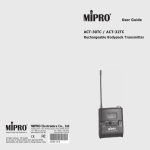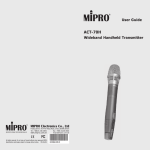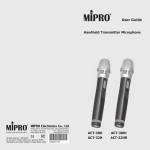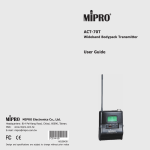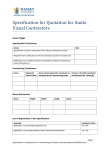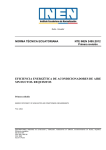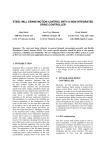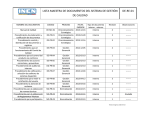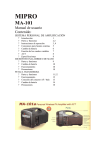Download MIPRO ACT-50H
Transcript
User Guide ACT-50H / ACT-52H Handheld Transmitter All rights reserved. Do not copy or forward without prior approvals MIPRO. Specifications and design subject to change without notice. MN 014/03 2 CE 4 9 4 A Handheld Transmitter Handheld Transmitter CONTENTS 2 HANDHELD CONTROLS AND INDICATORS 3 BATTERY INSTALLATION 4 PROPRIETARY DESIGN TO AVOID ACCIDENTAL POWER ON/OFF 5 LCD SCREEN 6 BATTERY STATUS 7 CAUTIONS HANDHELD CONTROLS AND INDICATORS 1 2 3 4 5 6 GROUP CHANNEL BAT 7 1 8 1 Top Grille: Protects detachable microphone capsule module and internal foam prevents breathing, wind and POP noises. 2 Upper Housing: Houses transmitter PCB and battery compartment. 3 LCD Screen: Displays group, channel, battery status and error code. 4 Lower Housing: Protects battery compartment and holds batteries. 5 Power On-off Switch: Slide the power switch to the “ON” position for use or to the “OFF” position when not in use. 6 Color Coded Protection Cap: Protects against accidental power on/off. Available in different colors for channel differentiation. 7 ACT Infrared (IR) Port: Receives signals from receiver to synchronize frequencies. 8 Battery Compartment: Accommodates two 1.5 Volt (AA) batteries. 2 Handheld Transmitter Handheld Transmitter BATTERY INSTALLATION PROPRIETARY DESIGN TO AVOID ACCIDENTAL POWER ON/OFF 4 The protective handheld cap prevents accidental power on/off and protects internal components. REMOVE HANDHELD TRANSMITTER CAP: (Figure 1) 1. Unscrew lower housing direction. 2. Insert two 1.5 Volt (AA) batteries into the battery compartment according to the correct polarity as shown in Figure 1. When batteries are installed correctly, the battery meter in the LCD screen will show the current battery strength. 4 in counter-clockwise Power OFF Transmitter. Unscrew Lower Housing. Pull out the cap. INSTALL HANDHELD TRANSMITTER CAP (Covers On/Off Switch): NOTE: When microphone is not in use make sure the microphone is switched off. If the microphone will not be used for some time, please remove the batteries from the battery compartment to avoid battery leakage which could result in damage to the microphone. Power ON Transmitter. Unscrew Lower Housing. Pull out, reverse and push in cap. Fasten lower housing back in place Caution: We recommended the cap is fitted during operation. 3 4 Handheld Transmitter Handheld Transmitter BATTERY STATUS LCD SCREEN GROUP CHANNEL BAT ERR ! ERR Message: When “ERR” appears in the display it indicates that an operational error has occurred. Please refer to the following codes to diagnose which error you are experiencing. ERR no01 EEPROM is not being programmed or internal data error. ERR no02 For testing only. ERR no03 The frequency you want to program is above the switching bandwidth of the transmitter. Use a receiver with an appropriate frequency group. (At this time the microphone is still operating and the frequency remains unchanged. To clear the displayed "ERR" message, switch the handheld transmitter off and on again.) ERR no04 100% 80% 40% 10% 0% Indicates the power remaining in the transmitter battery. When the battery has less than 10% power remaining it must be replaced or recharged. If an under voltage condition continues, the LCD will show “Poff” and the system will shut down to prevent being overly discharged. “Poff” - Power Off : When the power switch is turned off, the LCD will show “Poff” (for Power Off) first and then the system will shut down and no further messages will be displayed. The frequency you want to program is below the switching bandwidth of the transmitter. Use a receiver with an appropriate frequency group. (At this time the microphone is still operating and the frequency remains unchanged. To clear the displayed “ERR” message, switch the handheld transmitter off and on again.) ! “Group” & “Channel”: When both the group and channel numbers are displayed, it means that you are using the pre-programmed frequency of the receiver. ! “Channel” Only: If “Channel” only is displayed, it means that you are using a frequency which is not preprogrammed. 5 6 Handheld Transmitter Handheld Transmitter & IC - ID CAUTIONS 1. The ACT-52H has an integrated antenna at the end of the rear housing (covered by the color protective cap). Performer should avoid holding the microphone over or near the antenna section as this will deteriorate transmission efficiency. Severe deterioration if performer directly covers up the antenna section with both hands. 2. Many performers tend to hold the microphone by the top grille. Unfortunately, this position seriously degrades both the sound quality and directionality of a microphone. Even the most expensive microphones will have its original sound quality compromised by this method. Grabbing a microphone by the grille will isolate the capsule's acoustic resonance circuit and or change the capsule resonator's frequency. This results in an inferior performance in both frequency response and the separation of directionality. In addition, a palm's sound-focusing effect will tend to strengthen resonances in certain frequencies and can cause unwanted echo. THIS DEVICE COMPLIES WITH PART74 OF THE FCC RULES AND RSS-123 ISSUE 2 OF CANADA. OPERATION IS SUBJECT TO THE FOLLOWING TWO CONDITIONS: (1) This device may not cause interference. (2) This device must accept any interference, including interference that may cause undesired operation of the device. This equipment complies with FCC RF radiation exposure limits set forth for an uncontrolled environment. Le présent appareil est conforme aux CNR d'Industrie Canada applicables aux appareils radio exempts de licence. L'exploitation est autorisée aux deux conditions suivantes : (1) l'appareil ne doit pas produire de brouillage, et 3. A proper technique is required for using directional microphones because the distance between the microphone and your mouth has a significant impact on sensitivity and performance. There is an inverse relationship between microphone sensitivity and the distance from the mouth to the microphone. Consequently, performers with a ''weaker'' sound level cannot expect to hold the microphone too far away from their mouth and compensate by turning up the amplifier volume to increase the sound level as this can easily cause echo or feedback. In contrast, performers with a ''louder'' sound level should not hold the microphone too close as this can easily result in distortion by causing the amplifier system to be overloaded. (2) l'utilisateur de l'appareil doit accepter tout brouillage radioélectrique subi, même si le brouillage est susceptible d'en compromettre le fonctionnement. Disposal Dispose of any unusable devices or batteries responsibly and in accordance with any applicable regulations. Disposing of used batteries with domestic waste is to be avoided! 4. Furthermore, a large-diaphragm directional microphone has a very distinct proximity effect. When the microphone is close to the mouth, the bass response is strengthened as the distance gets closer. Therefore, if a performer's sound is insufficient in bass, they can hold the microphone closer and use the proximity effect to help compensate for the lower bass level. Conversely, if a performer's voice is too heavy in the bass register, increasing the distance between the microphone and their mouth will decrease the proximity effect and reduce the bass response, thus making their voice become clearer and brighter. 5. It is recommended to keep the grille and sponge windscreen clean to avoid any substance blocking the proximity effect of the microphone. 7 2005-08-13 Batteries/NiCad cells often contain heavy metals such as cadmium(Cd), mercury(Hg) and lead(Pb) that makes them unsuitable for disposal with domestic waste. You may return spent batteries/accumulators free of charge to recycling centers or anywhere else batteries/accumulators are sold. By doing so, you contribute to the conservation of our environment! 8





